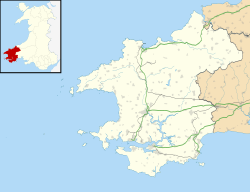| Herbrandston | |
|---|---|
 View of St. Mary's church, Herbrandston | |
Location within Pembrokeshire | |
| Population | 397 (2011) [1] |
| OS grid reference | SM899061 |
| Principal area | |
| Country | Wales |
| Sovereign state | United Kingdom |
| Post town | MILFORD HAVEN |
| Postcode district | SA73 |
| Dialling code | 01646 |
| Police | Dyfed-Powys |
| Fire | Mid and West Wales |
| Ambulance | Welsh |
Herbrandston is a village, parish and community on the north side of the River Cleddau, in Pembrokeshire, Wales. It is located to the west of Milford Haven and Hakin and east of St Ishmael's. Before 1960 and the building of the ESSO oil refinery, the village only had a population of 200; as infrastructure grew, so did the population. The size of the village increased within a matter of years, as housing estates associated with the refinery were built. The village has a population of 397, 15 per cent of which is Welsh-speaking.


